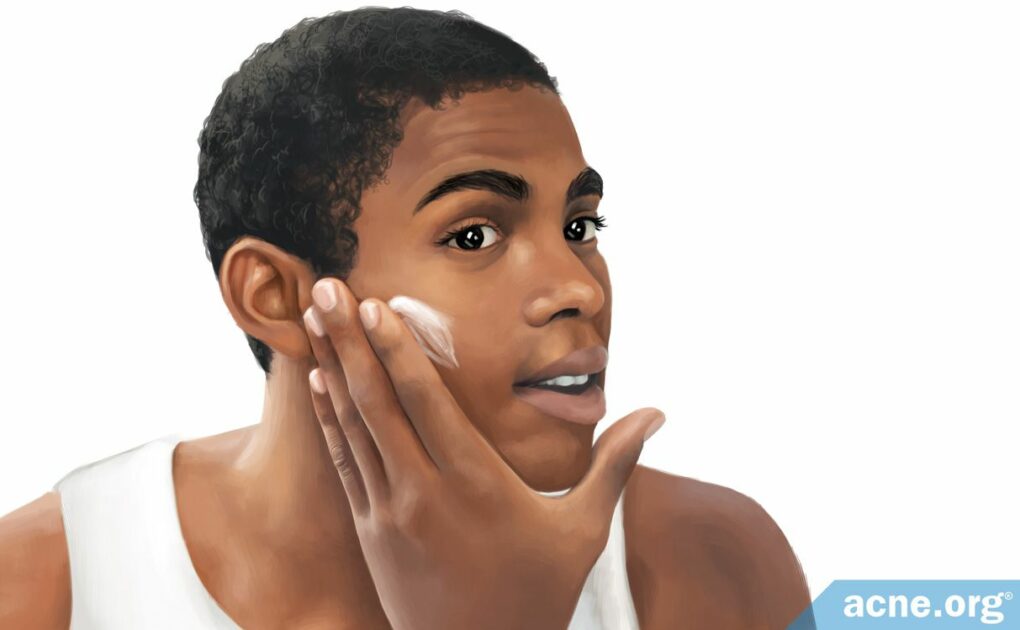Probably, Though Exactly How It Helps Is Unclear. Be Sure to Stay Gentle.

The Essential Info
Research suggests that rubbing topical medications into the skin improves absorption, making the treatment more effective. Out of five studies, four found that rubbing or massaging the skin immediately before or after applying a topical medication increased the amount of medication that penetrated the skin. The fifth study found that rubbing in the treatment made no difference–in other words, it was no better or worse than just placing the product on the skin.
Therefore, research shows us that it is a good idea to lightly massage topical acne medications into the skin, but this should be done with a featherlight touch because physical irritation of the skin can make acne worse. A good way to think about it is that you want to “move the medication around” until it is absorbed. Don’t “press it into the skin” or give your skin a vigorous massage. Just move the medication around until it’s absorbed.

The Science
- Studies Showing That Rubbing the Skin May Improve Absorption of Topical Medications
- Study Disputing That Rubbing the Skin Improves Absorption of Topical Medications
- How Rubbing or Massaging the Skin May Improve Absorption
- The Bottom Line
When we apply medicated creams, gels, or ointments to the skin, many of us instinctively massage them in. Ever wonder why we do that, and whether it makes any difference to how well the treatment works? Fortunately for us, scientists have wondered! Their experiments show that rubbing or massaging the skin right before or after applying a topical treatment most likely helps with absorption–and the better the medication penetrates the skin, the more effective it will be.
Exactly how rubbing or massaging the skin improves the absorption of medication is still unclear, although scientists have a few ideas. If you are curious to know more about their experiments, let’s dive into the research!
Studies Showing That Rubbing the Skin May Improve Absorption of Topical Medications
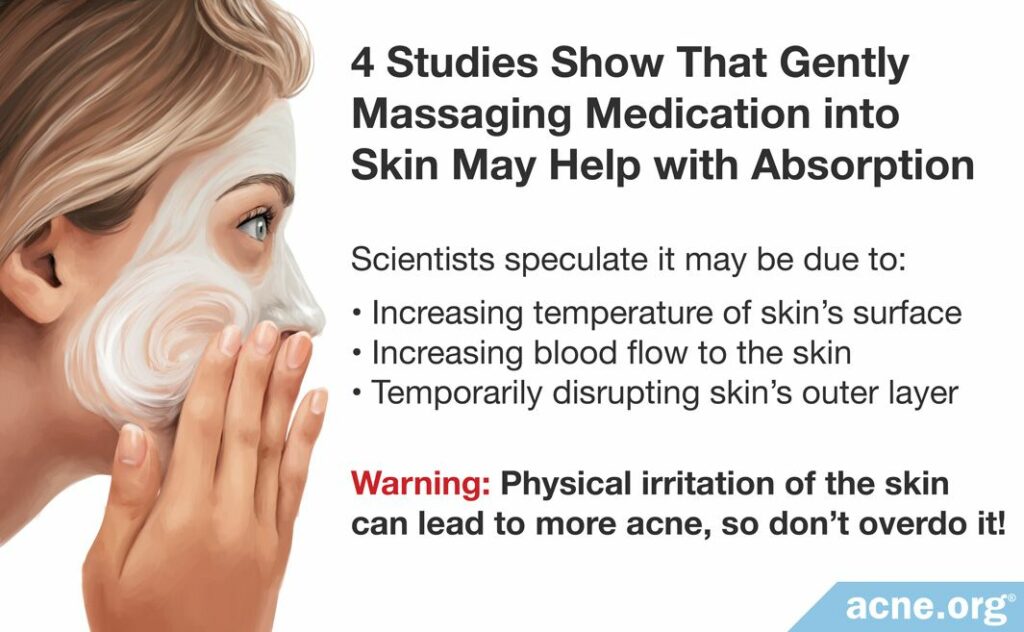
Four studies have found that rubbing or massaging the skin seems to improve the penetration of medications into the skin. We should note that all these studies experimented on human or animal skin samples in the lab that were no longer attached to a human or an animal, and not on the skin of living patients. In other words, we cannot be absolutely sure that things would work exactly the same way in real people.
Study #1: Rubbing an acne medication in with a gloved finger improves absorption
The first study looked at how well salicylic acid, a topical acne medication, penetrates pig skin. In Experiment 1, the researchers rubbed the medication into the skin with a gloved finger for 15 seconds. In Experiment 2, they just applied the medication to the skin without any rubbing. The scientists then measured the amount of medication remaining on top of the skin as well as the amount that ended up in each layer of the skin.
In Experiment 1, less salicylic acid remained on the skin surface and more was found in every skin layer compared to Experiment 2. In other words, rubbing acne medication in with a finger results in better absorption than simply placing the medication on top of the skin. The scientists wrote, “The present study is…the first one to investigate the effect of rubbing a topical acne medication…on [the] skin surface on drug penetration.”1
Expand to reveal details of study
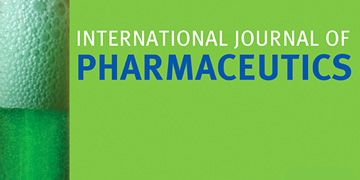
The study was published in 2017 in the International Journal of Pharmaceutics. The researchers applied 2% salicylic acid to a sample of pig ear skin for 15 seconds, either with rubbing or with no rubbing. For rubbing the skin, they tested four different tools: a vertical glass rod, a horizontal glass rod, a laboratory device called a rheometer, and a gloved finger.
The scientists found the worst absorption of salicylic acid in the samples after no rubbing with any tool. The greatest absorption occurred in the samples rubbed with a gloved finger. The researchers speculated that rubbing helped spread the salicylic acid, increasing the skin area that came in contact with the medication.1
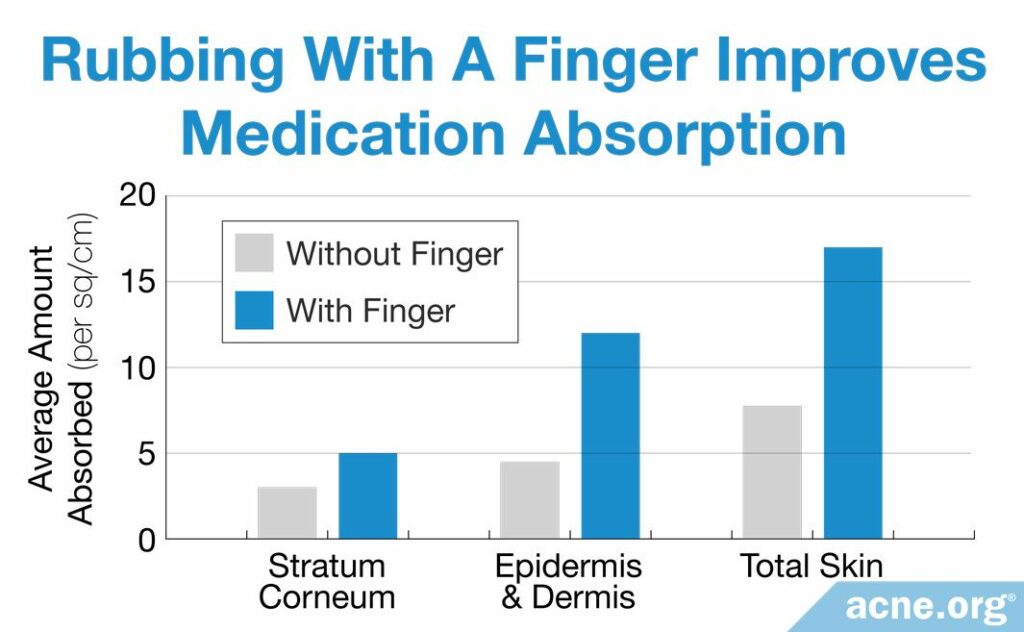
Study #2: Rubbing an anti-inflammatory medication into the skin improves its absorption
The second study looked at whether an anti-inflammatory medication called diclofenac penetrates the skin better when rubbed in. The researchers applied diclofenac gel to a human skin sample for 45 seconds with or without rubbing. They found that rubbing improved absorption of the medication five-fold. The scientists also observed that without rubbing, the medicated gel tended to accumulate in the superficial layers of the skin, whereas after rubbing, it passed deeper into the skin. The researchers wrote, “[A]pplication of diclofenac…with a 45 s rubbing tended to result in higher accumulation in the stripped skin…without rubbing it tended to remain in the superficial skin layers.”2
Expand to reveal details of study

This study was published in 2012 in the journal BMC Research Notes. The researchers applied a single dose of 5 mg/cm2 of diclofenac gel to excised human skin. After one hour, they measured how much gel had passed into each layer of the skin. They also measured the electrical resistance of the skin, which indicates how difficult it is for substances to penetrate the skin. The researchers found that rubbing the medication in decreased electrical resistance two-fold.2
Study #3: Massaging the skin for 30 seconds before applying an ointment improves absorption
The third study tested whether massaging the skin before applying a medicated ointment improved absorption of the medication. The researchers lightly massaged a rat skin sample for 30 seconds and then applied an ointment containing triamcinolone acetonide, a steroid medication used for treating skin conditions like allergic rash. They measured how much ointment permeated this skin sample and compared it to another sample where ointment was applied without massage. The researchers found that massaging the skin increased absorption of the medication nine-fold over 24 hours.3
Expand to reveal details of study
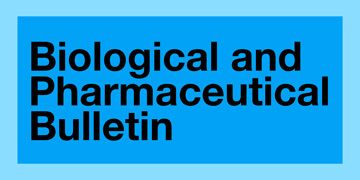
This study was published in 2010 in the journal Biological and Pharmaceutical Bulletin. The researchers tested excised samples of hairless rat skin. They applied an ointment containing 1% triamcinolone acetonide to the skin. For some samples, they massaged the skin for 30 seconds at a pressure of 1.87-3.12 N/cm2 before applying the ointment. After 24 hours, the researchers measured absorption of the medication and also measured the skin’s resistance to flow of substances across it. The resistance was three times lower in massaged skin than in non-massaged skin. Therefore, the researchers concluded that massaging the skin before applying medication makes the skin more permeable.3
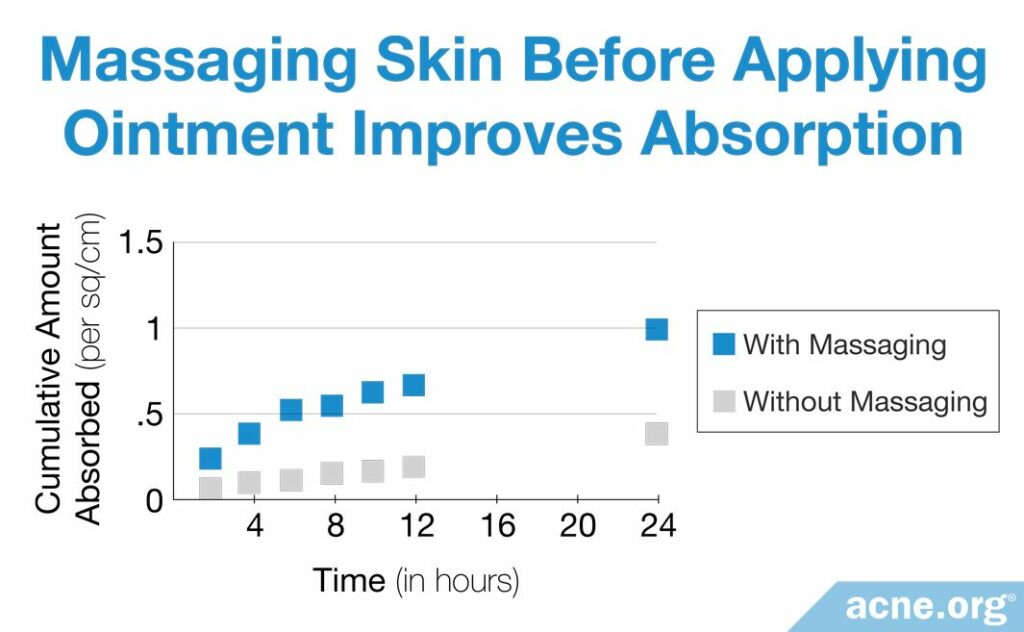
Study #4: Applying pressure to the skin improves absorption of a topical medication
The fourth study tested whether applying pressure to the skin improves absorption of another topical medication, caffeine. This experiment is relevant because when we massage or rub the skin, we are applying pressure to it.
After placing the caffeine on top of a skin sample, the researchers applied pressure to the skin for 30 minutes. We should note that this is a very long time, much longer than most people rub the skin when applying a medication. The researchers found that the pressure almost doubled the absorption of caffeine into the skin.4
Expand to reveal details of study

This study was published in 1993 in the journal Acta Dermato-venereologica. In the first experiment, the researchers applied equal 5 mg/cm2 doses of caffeine to two skin samples from a biopsy. For one of the two samples, they also applied a pressure of 0.25 bar over atmospheric pressure for 30 minutes. At the end of 30 minutes, both skin samples had absorbed the same amount of caffeine.4
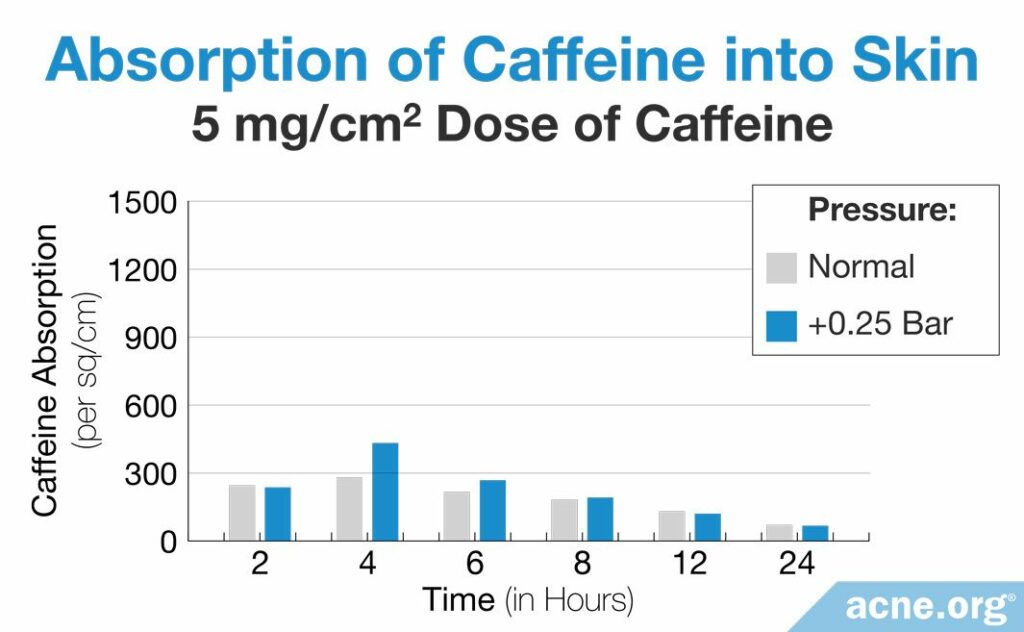
In the second experiment, the researchers increased the dose of caffeine to 240 mg/cm2 and then repeated the same procedure. This time, the sample that received pressure absorbed 1.8 times as much caffeine as the sample that did not receive pressure. The researchers concluded that pressure on the skin can increase absorption, depending on the amount of topical medication.4 However, it is difficult to say whether the dose they used was realistic for a topical product.
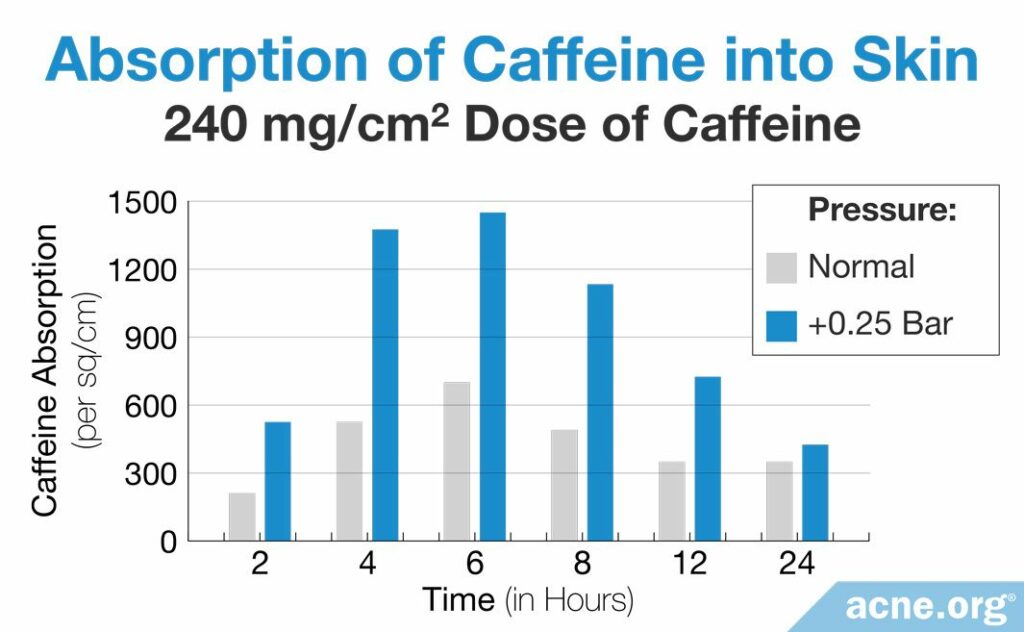
Summing up the results of these four studies, it looks like rubbing or massaging the skin before or after applying a topical medication significantly improves absorption. The studies found that the skin absorbs medications as much as 2-9 times better when rubbed.
However, one conflicting study found that rubbing made no difference to how well the skin absorbed a topical medication. Unlike the other four studies, which tested skin samples, this was a very rigorous clinical trial conducted in patients. Normally, that would mean we should trust the results of this study more than the others. However, the researchers did not directly measure absorption of the drug into the skin. Instead, they looked at how much the patients’ improved after applying a medication with or without rubbing it into the skin. In other words, they did not directly measure what we are most interested in, so we cannot give the results of this study too much weight.
Let’s take a look.
Study Disputing That Rubbing the Skin Improves Absorption of Topical Medications
This study compared absorption of a medicated spray with or without rubbing into the skin. Fifty patients with eczema on the arms or legs applied a spray containing a topical steroid medication to the affected limbs three times a day for two weeks. However, on one side of the body, they rubbed the spray into the skin, while on the other side, they let the spray absorb on its own. After two weeks, the researchers compared eczema symptoms on the two sides of the body. They found that symptoms on both sides had improved equally. In other words, rubbing the skin did not make the treatment more effective. The researchers wrote, “Both the no-rub and rub techniques resulted in significant clinical…improvement of mild eczema…Moreover, there was no difference in [symptoms] between the no-rub and rub techniques.”5
Again, we should keep in mind that the researchers only measured improvement in symptoms, not how much drug penetrated the skin. In other words, it is possible that rubbing did increase drug absorption somewhat, but not enough to further improve the patients’ symptoms.
Expand to reveal details of study

This study was published in 2015 in the Journal of Cosmetic Dermatology. Fifty patients 18 years of age or older participated in the study. It was a randomized controlled clinical trial, which means that for each patient, the researcher randomly chose which side of the body received the rubbed-in medication and which just received medication placed on top of the skin. The scientist was also “blind” to the procedure, meaning that when she was evaluating the patients’ symptoms at the end of the study, she did not know which side had been rubbed. This makes the results of the study very trustworthy.
As symptoms of eczema, the researcher looked for skin irritation, redness, peeling (desquamation), roughness, and dryness, and evaluated overall skin appearance. All symptoms improved to almost exactly the same degree on both sides of the body. In other words, rubbing the treatment into the skin on one side of the body failed to cause greater improvement on that side.5
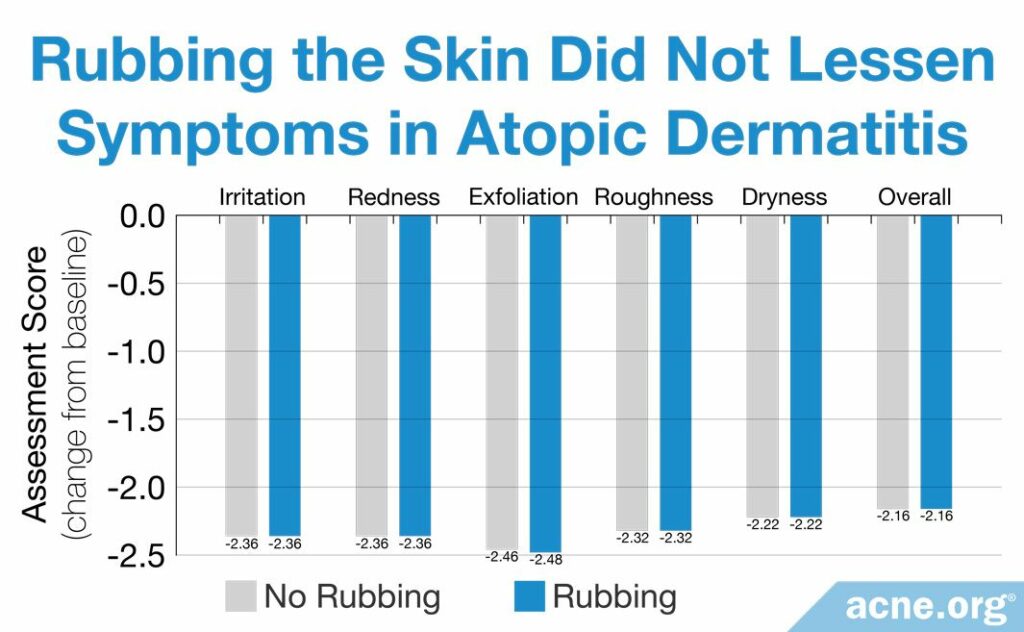
How Rubbing or Massaging the Skin May Improve Absorption
Scientists speculate that rubbing or massaging the skin may improve absorption of medication either by increasing the temperature of the skin, improving blood flow to the skin, and/or temporarily disrupting the skin surface so that substances can more easily penetrate it. If you are curious to know more about how this might work, expand the section below.
How rubbing or massaging the skin may improve absorption: The full scoop
To understand how rubbing the skin may improve absorption, we need to first look at how medications penetrate the skin. There are three ways this can happen:
1. Intercellular route: Some medications pass through the spaces in-between skin cells into deeper tissues.
2. Intracellular/transcellular route: Most medications pass through skin cells themselves, by entering a cell from one side, passing through it, and exiting on the other side.
3. Trans-appendicular route: Some medications move through skin pores (hair follicles and sweat ducts), using them like tunnels through the skin.6
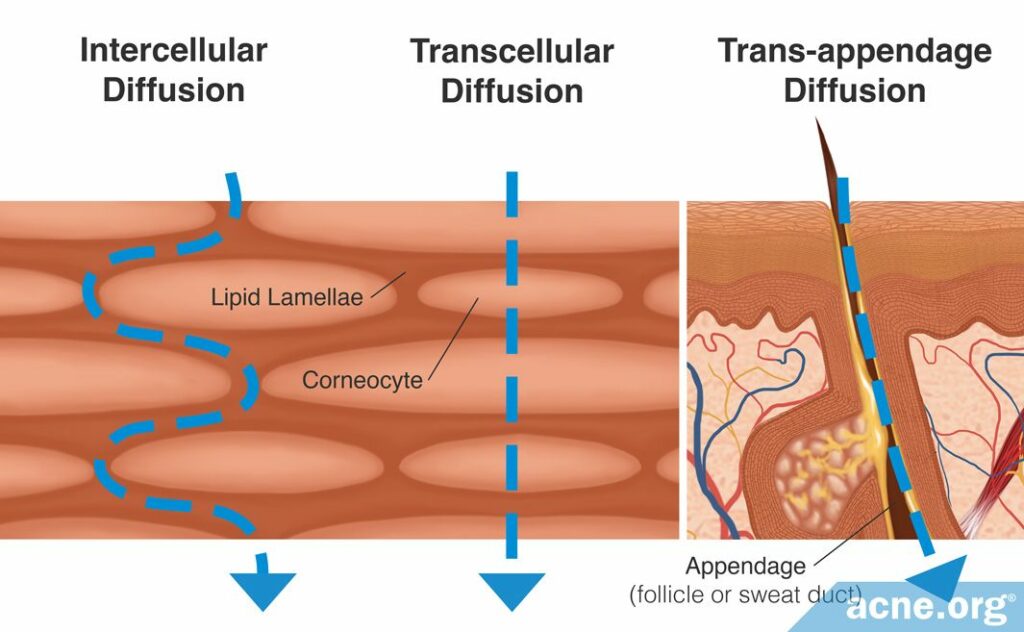
Scientists speculate that rubbing or massaging the skin may improve the ability of medications to penetrate the skin in three ways:4,7
1. Increasing the temperature of the skin surface: Rubbing warms up the skin and any medication placed on top of the skin. The warmer the medication is, the faster its molecules can move around and the faster they can travel into the skin.
2. Increasing blood flow to the skin: Rubbing or massaging the skin redirects more blood to the spot being rubbed. More blood flow near the skin surface means the medication can reach the bloodstream faster and therefore start working sooner.
3. Temporarily disrupting the outer layer of the skin: Rubbing may briefly create tiny “gaps” in the skin surface, allowing more medication to pass through.
The Bottom Line
Research suggests that lightly rubbing the skin probably does improve absorption of topical medications. Theoretically, the more medication absorbed, the stronger the medicinal effect. Therefore, it is a good idea to gently rub topical medication into the skin, moving the medication around until the skin absorbs it. However, remember to use a featherlight touch and avoid pressing on the skin, as this can cause irritation and make your acne worse.
References
- Nguyen HX, Puri A, Banga AK. Methods to simulate rubbing of topical formulation for in vitro skin permeation studies. Int J Pharm. 2017;519(1-2):22-33. doi:10.1016/j.ijpharm.2017.01.007 https://www.ncbi.nlm.nih.gov/pubmed/28062367
- Hasler-Nguyen N, Fotopoulos G. Effect of rubbing on the in vitro skin permeation of diclofenac-diethylamine 1.16% gel. BMC Res Notes. 2012;5:321. doi:10.1186/1756-0500-5-321 https://www.ncbi.nlm.nih.gov/pubmed/22720797
- Ishii H, Todo H, Sugibayashi K. Effect of Sebum and Ointment Rubbing on the Skin Permeation of Triamcinolone Acetonide from White Petrolatum Ointment. Biol Pharm Bull. 2010;33(5):876-880. doi:10.1248/bpb.33.876 https://www.ncbi.nlm.nih.gov/pubmed/20460769
- Treffel P, Panisset F, Humbert P, Remoussenard O, Bechtel Y, Agache P. Effect of pressure on in vitro percutaneous absorption of caffeine. Acta Derm Venereol. 1993;73(3):200-202. doi:10.2340/000155555573200202 https://www.ncbi.nlm.nih.gov/pubmed/8105619
- Draelos ZD. Triamcinolone spray: no-rub application as effective as rub application. J Cosmet Dermatol. 2015;14(4):286-290. doi:10.1111/jocd.12161 https://www.ncbi.nlm.nih.gov/pubmed/26133561
- Szunerits S, Boukherroub R. Heat: A Highly Efficient Skin Enhancer for Transdermal Drug Delivery. Front Bioeng Biotechnol. 2018;6:15. doi:10.3389/fbioe.2018.00015 https://www.frontiersin.org/articles/10.3389/fbioe.2018.00015/full
- Hinds T, McEwan I, Perkes J, Dawson E, Ball D, George K. Effects of massage on limb and skin blood flow after quadriceps exercise. Med Sci Sports Exerc. 2004;36(8):1308-1313. http://www.ncbi.nlm.nih.gov/pubmed/15292737. Accessed August 27, 2019.
 Acne.org Products
Acne.org Products